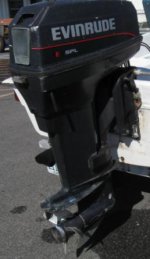I have a 1996 Evinrude 50hp 2 stroke. Earlier this summer the down side of the power tilt stopped working. After swapping around the relays, it started working again, so I thought I had found the culprit, until I swapped them back, and it CONTINUED to work. Shortly thereafter it stopped working again. I ordered new relays and got the same result, no down tilt.
Both the throttle switch and the switch on the motor work for the up function. Only a "click" is heard when pressing the down button from either location. The tilt motor works fine on the up side, so I don't think it's a fluid issue. The clicking I can hear coming from the relay leads me to believe that the relay is working fine, but there must be another electrical issue that I'm missing. I've by been lowering the motor by releasing pressure with the screw, not ideal.
I have the manual but it covers so many models and years that it is hard to follow. Can anyone suggest a trouble shooting method or some other things to try?
Thanks!
- Mike
1976 Whaler 15
1996 Evinrude 50 SPL

Both the throttle switch and the switch on the motor work for the up function. Only a "click" is heard when pressing the down button from either location. The tilt motor works fine on the up side, so I don't think it's a fluid issue. The clicking I can hear coming from the relay leads me to believe that the relay is working fine, but there must be another electrical issue that I'm missing. I've by been lowering the motor by releasing pressure with the screw, not ideal.
I have the manual but it covers so many models and years that it is hard to follow. Can anyone suggest a trouble shooting method or some other things to try?
Thanks!
- Mike
1976 Whaler 15
1996 Evinrude 50 SPL


